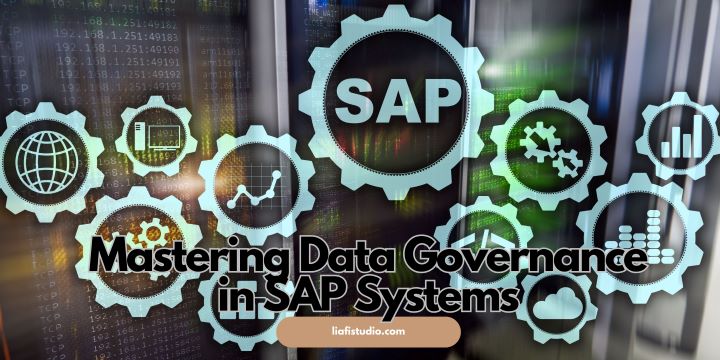Unraveling the complexities of data governance within SAP data management frameworks signifies a critical mission for enterprises aiming to leverage their data as a strategic asset. It’s a multidimensional approach that demands a harmonious blend of technology, people, and processes to uphold data quality and regulatory compliance and foster a data-driven decision-making culture. This extensive exploration will delve into the key aspects of data governance in SAP environments, unveiling its significance, its transformative role, and how enterprises can proficiently embed its principles to thrive in the digital economy.
Table of Contents:
- Key Takeaways
- Understanding Data Governance
- Importance of Data Quality
- Security in Data Management
- Evolving Data Ecosystems
- Innovation Through Analytics
- Strategic Integration of Data
- AI, ML, and Data Management
- Future of Data Governance
- Implementing Data Governance Strategies
- Conclusion: Navigating the Data Governance Landscape
Key Takeaways:
- Data governance ensures integrity, quality, and security within SAP systems.
- Advances in data management technology, such as AI and ML, are revolutionizing how we use and interpret data.
- Integrating analytics into governance frameworks can transform raw data into insightful business assets.
- Ensuring the organization stays agile in the evolving data management landscape is key to maintaining a competitive edge.
Understanding Data Governance
Data governance is more than just a set of rules; it’s a comprehensive system that defines who can act upon what data, in which situations, and using what methods. It incorporates everything from data quality, accessibility, and lifecycle management to ensuring compliance with privacy laws and corporate policies. In SAP systems, where data is the engine of the enterprise, governance becomes even more critical. It ensures that the data fueling processes, from supply chain management to customer relationship strategies, are systematically controlled and optimally utilized. Navigating this territory requires a refined strategy that aligns with the broader business objectives while fostering an environment where data is used ethically and effectively.
Importance of Data Quality
In the context of SAP, data quality is pivotal: it is the difference between accurate forecasting and misguided conjectures, between fruitful customer relationships and unsatisfactory experiences. Quality in data begets trust, and trust is paramount in a world teeming with information. Companies with high data quality can make confident decisions based on analytics that accurately reflect the operational reality of the enterprise. It’s about crafting clean, complete, consistent, and contextual data — qualities that, when ensured, arm businesses with a clear line of sight into their operations and market opportunities.
Security in Data Management
Ensuring stringent data security protocols within SAP systems is akin to building a fortress around the heart of an enterprise’s operations. The cost of data breaches extends well beyond financial ramifications to include legal repercussions and irreversible damage to customer trust. Thus, a robust data governance strategy must encompass stringent security measures that maintain critical data confidentiality, integrity, and availability. Encryption, access controls, audit trails, and regular security assessments become indispensable, creating a secure digital environment for all stakeholders.
Evolving Data Ecosystems
As organizational needs change and technology advances quickly, the SAP data ecosystems adapt and evolve. They are no longer static entities but dynamic, interconnected webs that extend into cloud computing, big data, and beyond. This continual evolution demands agile governance that can pivot and shift to meet the new facets of digital transformation. The interoperability across business networks, enhanced by state-of-the-art SAP solutions, necessitates that stewardship and governance paradigms mature and grow to encompass broader scopes and deeper insights.
Innovation Through Analytics
Robust analytics in an SAP context is transformative, transmuting every byte of data into precious wisdom and foresight. Here, data governance guides channel analytics in the right direction — ensuring data is reliable enough to draw sound conclusions. Analytics enables prediction of market trends, identification of new revenue channels, and enhancement of customer engagement. Additionally, it is crucial in process optimization, rooting out inefficiencies and enabling a keener strategic focus. This translates to a more resilient enterprise, one that can not merely survive but also thrive on innovation.
Strategic Integration of Data
The challenge of data integration in SAP systems extends beyond technical execution; it’s about harmonizing data from many sources, platforms, and formats into a unified narrative. It’s the construction of a cohesive data story from scattered chapters. Strategic integration under the governance umbrella ensures this story remains coherent and aligned with organizational strategies. Assimilating various data sources eliminates data silos, encourages interdepartmental coordination, and enhances overall transparency — empowering businesses to harness the complete, unadulterated power of their collective data.
AI, ML, and Data Management
Artificial intelligence and machine learning are recasting the mold of traditional data governance in SAP systems. These intelligent technologies are automating mundane data processes, providing predictive insights, and evolving governance frameworks to be more intelligent and responsive. The fusion of AI and ML with data governance is streamlining the path from data collection to insight generation. For instance, machine learning algorithms can analyze patterns and behaviors within the data to improve operations, customer satisfaction, or even regulatory compliance. These innovations pave the way for a new horizon of possibilities in data management — one where accuracy and foresight lead to a pronounced competitive advantage.
Future of Data Governance
The path forward for data governance in SAP systems shines bright, with advancements pointing toward seamlessly efficient, intuitive governance structures. Yet, the key to mastering this future is remaining adaptive to change and proactively adopting new methodologies. Organizations must establish a robust framework and cultivate a governance culture that evolves to meet the burgeoning needs of a data-centric world. The forthcoming landscape promises to refine governance processes and elevate the strategic role of data in driving business success.
Implementing Data Governance Strategies
Materializing a data governance strategy within an SAP system is more akin to a marathon than a sprint; it requires endurance, foresight, and a relentless commitment to continuous improvement. Drafting the blueprint hinges upon thoroughly analyzing the current data landscape, business objectives, and technological capabilities. Setting up a governance structure with clearly defined roles, responsibilities, and policies steers the organization toward disciplined execution. Monitoring, measuring, and refining the approach are continuous tasks that align the strategy with the enterprise’s changing needs and the volatile landscape of the digital world.
Conclusion: Navigating the Data Governance Landscape
In the grand tapestry of enterprise technology, data governance in SAP systems represents a crucial thread. With diligence, vision, and the right practices, organizations can master the art of data governance, propelling themselves into an era of unprecedented analytic capabilities and operational excellence. As data continues to command the strategic direction of enterprises, those adept at its governance will emerge as leaders, carving a path through the digital frontier that others strive to follow.






